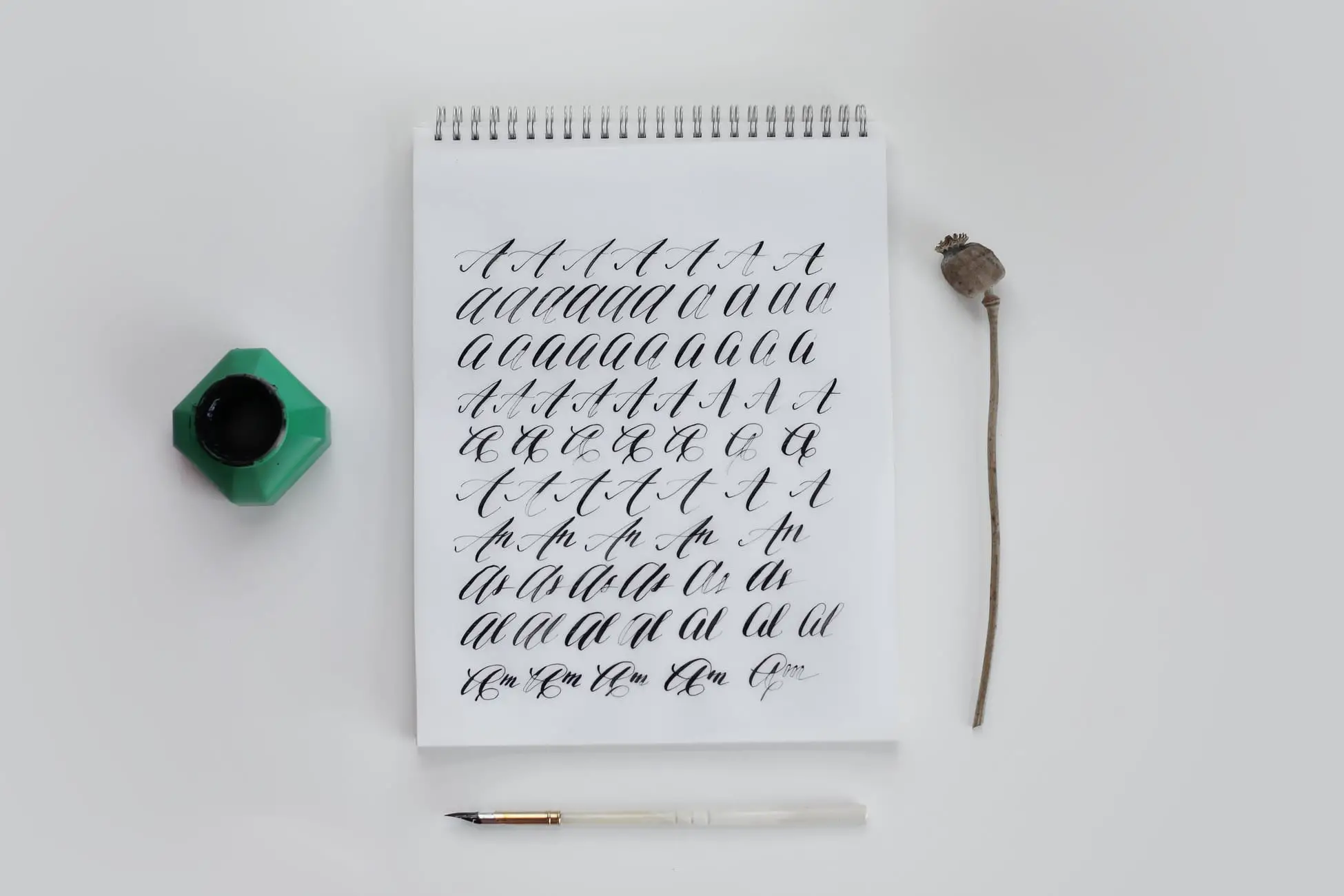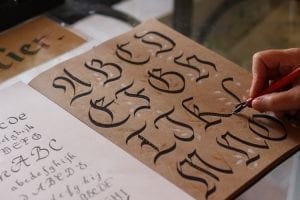
Calligraphy is the art of writing beautifully, with the proportions of letters in harmony. The visual appeal of this skill is indicative of the in-depth knowledge about the written form and the ability to create pieces of handwritten work that is impressive and highly stylized.
Origin of the term
The term calligraphy comes from the Greek ‘Kallos’ or beauty and ‘Graphein’ or to write. Many civilizations, especially certain Asian and Middle Eastern countries, celebrated and highly appreciated this art form. It is evident across a number of manuscripts and archeological sites across these countries, even today.
Calligraphy was popular until the advent of printing. This was because handwritten documents couldn’t be reproduced with the same quality and in the required numbers as printed documents could be. This may have reduced its relevance in mainstream publishing circles, but its relevance continues in invitations and greetings, that are elevated by the touch of specialized writing.
Arabic writing
The styles used in Arabic writing have become synonymous with the exquisiteness and charm of writing. Before written documents, Islam was recorded as inscriptions in stone. The popular attraction to the written Arabic language lies in its unique way of being written right to the left. There are no capitalized letters and some letters have dots on top, while others have at the bottom. This, and other features, like some letters being joined with letters in the front, lend it its unique appeal.
The instrument used for writing in Arabic calligraphy is a Qalam, which is cut at the writing point at an angle. It results in a thick downstroke while the upper stroke is thin. The careful movements of the writer and the Qalam provide a fluidic movement that results in perfectly aligned letters that are pleasing to see.
Forms of Arabic writing
There are roughly two forms of Arabic writing- the cursive and the Kufic. The papyri discovered in Egypt was written largely in the cursive script, which did not seem to have rigorous rules. However, the Kufic script, which was used mostly as a part of religious text, had a set of guidelines that made it easier to be followed.
Though the Kufic writing is believed to have been founded in a city in Mesopotamia around 683 CE, the veracity of the exact origins remains unknown. The manuscripts of the holy Quran were written using this script and were oblong, rather than the more popular codex format.
The large writings usually consisted of only about a couple of sentences on every page and were grandiose and measured. Though this form of writing was still popular as decorative writing adorning wall hangings and gifts, it wasn’t in use in general, close to the 11th century.
This may have been due to the popular use of a relatively new script of writing, called the Nashki, that was even used while copying the Quran. Two people who worked in Mesopotamia, Ibn al-Bawwab and Ibn Muqlah, have been credited with developing this cursive script.
Arabic writing in Spain
As geographical regions varied, there were unique methods of writing that were developed. Maghribi was one such form of Arabic writing that became popular in Spain, soon becoming the popular script used to write the Quran. This derivative of the Kufic form is known for its horizontal aspects and the open curves that are crafted below register in the middle
Contributions from Persia and Turkey
Arabic was the language of communication in these countries. The Taliq was developed in Persia and was characterized by each word dropping down when compared to the earlier one. Mir Ali, a famous calligrapher, developed Nastaliq, which is widely used to write Persian text due to its fluidic charm.
Divani is another enchanting script, but which was developed by the Ottoman Turks, and which was also a little difficult to read.
The art of fine handwriting, calligraphy was a great appeal in the Islamic world, with a lot of significance given to style and skill. Many of the writings are still preserved across the world. Such writing was not limited to writing on papyrus and parchment; instead such exquisite handwriting was also found in tiles and in portable objects. Highly skilled experts were used to inscribe on the walls of monuments, sealing the beauty, and the craft for posterity.
Calligraphy in Indian Writing
The Arabic writing and its use of stylized symbols were carried forward to many countries in Asia, along with the Arabic traders. The scripts of Sanskrit were also influenced by such writing and were soon adapted.
The reign of the ruler Ashoka around 240 BC, brought with it an improved interest in the art. Known for his military success across the region, the king was known to be appreciative of all art forms. His indictments were inscribed in stone and gave rise to two popular Indian writing forms- Brahmi and the Kharoshti.
Unique writing forms and mediums in Indic writing
The material that was used for writing in India during the times was largely on copper, birch bark, and palm leaves. These were used even when writing on paper had begun in the Indian civilization.
The unique nature of these surfaces added their own advantages, guiding the written form to delicate lettering that enhanced visual appeal.

Highlights of writing popular in Greece
Sun-dried clay was the medium used for writing in ancient Greece, with a stylus used to scratch its surface in specific motions. Such scratched inscriptions were appealing to view but have been lost over the years. The durability of the clay medium was tested by the vagaries of nature, lending this format of writing unique to that day and age.
Other mediums that were use din ancient Greece included wax tablets, leather, wood, pottery, or even lead. Pens made of reed with their tip split were used to write on papyrus.
Christian Era and its influence on Calligraphy
Christianity brought with it its unique preference for folded sheets of papyrus, with many sheets folded together to form a book. The gospels were circulated in such ‘notebooks’ and included handsome margins and uniform writing.
Two hands of writing
There were two hands of writing, that of book hands and documentary hands. Book hands was a type of writing that was used for writing down literature verbatim, with a focus on being uniform and regular. Such work was carried out by professionals and was mainly used for administrative work and not meant to solely be of visual appeal.
Documentary hands, on the other hand, was a form of writing that embraced a stylized format, more by individuals. It was written by scribes to draw wills or even letters, in the cursive or running method of writing. Such scribed were extremely skillful, and sometimes, immersive in their style of writing with beauty and visual appeal in focus.
Writing during the Roman Era
The Roman writing form followed a cursive pattern that tended to be more angular and with regular letters. It was beautiful to look at and showed more formality that some of the other methods of writing. In the script called Haware, every letter that was written could be proportioned into identical squares, lending harmony of patterns.
Writing during the Byzantine Era
When Constantinople was founded, there was a new form of writing that was developed, which is best described as florid and exuberant. It had a continuity of writing and was the prevalent form for many centuries.
The Journey of Calligraphy
Calligraphy as an art form has survived many different civilizations and evolved into many different styles, written on varied mediums from barks to stone. The invention of papyrus brought with it a smooth edge to calligraphic writing, that was not possible before.
The dark ages saw an end to the growth of calligraphic writing, with creativity entering a void. However, the return of the Roman Catholics saw a renewed interest in this art form, with many different styles re-emerging.
Printing may have limited the use of handwriting but it brought in calligraphic fonts that continue to be used. Museums still showcase a wide variety of calligraphic inscriptions and art forms, raising public interest and awareness about this art form.
Many invitations and notes that are written to generate interest use such calligraphic art forms. Another popular means of the use of calligraphy is in tattoos, infusing unique styles to commonly used words. Some of the popular calligraphy fonts that are sued today include the Kanji Japanese calligraphy and the Arabic style of writing.
Calligraphy may not be used in mainstream documentation, but it still has vast appeal and charm that continues to make it one of the most popular art forms used during special occasions. This art form has undergone immense evolution and crossed barriers of geography, religion and language, to surface as a global art trend. Many civilizations have contributed to its rise and characteristics, lending their unique perspectives and creativity. Just like in our ancestors’ times, calligraphy continues to dot our lives across various mediums like carpets, wall hangings, books, invitations, pottery and more, engraving its relevance even during the modern times.